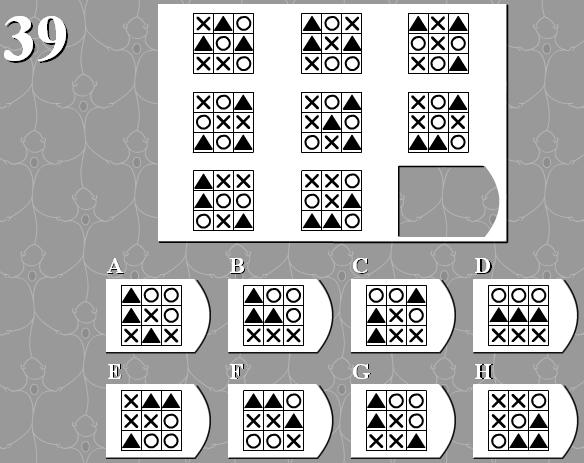What is the solution for this puzzle from this IQ test?
-
6$\begingroup$ -1. This question is too narrow, not searchable/indexable, unlikely to be of value to future visitors, nor to anyone finding the same puzzle in a different context, let alone a similar/equivalent puzzle anywhere at all. $\endgroup$– ClickRickJul 5, 2014 at 22:01
-
2$\begingroup$ @ClickRick, I'm not sure what do you mean. It is the first result among 600000 when you search for "task 39 iq test dk" in google. iqtest.dk itself is quite famous site, when you search for "iqtest.dk" in google you get 26 millions results. $\endgroup$– klm123Jul 6, 2014 at 4:44
-
1$\begingroup$ @ClickRick and why narrowness is bad? Broadness is bad, as far as I saw on SE and what is documented in FAQ. $\endgroup$– klm123Jul 6, 2014 at 4:49
-
$\begingroup$ The reason it's an issue is mostly because of the intent of self-answered questions - self-answered questions are good for sharing knowledge, but should really only be used for a specific problem that others will have and be able to find on Stack Exchange. In other words, the question needs to have significant intrinsic value to merit being self-asked and answered. $\endgroup$– user20Jul 7, 2014 at 6:43
-
3$\begingroup$ @Emrakul, I am tired to disagree, but is it written somewhere or it is your private opinion? I do not see anything like this here: puzzling.stackexchange.com/help/self-answer . And I do see exactly the opposite directions when I follow the first link there: "never hesitate to ask and answer your own question on any Stack Exchange site". $\endgroup$– klm123Jul 7, 2014 at 7:07
3 Answers
While kim123's answer is correct, there is a simpler logic shown by colors:
shapes are moving and morphing. For instance, the red cross begins its journey from the the upper left crossword box to the the (missing) lower left crossword box. Steps forward and transforms (rotates). The same happens for the blue triangle and the other shapes.
-
1$\begingroup$ Hi, I added spoiler markup to your answer. $\endgroup$ Feb 15, 2016 at 14:09
-
1$\begingroup$ Sorry, but what is this "simpler logic"? I completelly missing it from your answer. And what does colors means? Why you've highlighted very specivic parts of each picture, each time moving this part exactly by one cell? $\endgroup$– klm123Feb 15, 2016 at 17:15
-
1$\begingroup$ Ah, I see. You want to replace my 2rd and 3rd rule by "each cell moves in the writing direction". That's relly nice improvement. But still you need to explain it in you answer, it is totally unclear, especially because you highlighted a pair of cells, like their relations is important. $\endgroup$– klm123Feb 15, 2016 at 17:20
-
$\begingroup$ while accepted answer is changed but I believe kim123's answer what the puzzle designer intended. $\endgroup$ Feb 23, 2016 at 11:20
The answer is B.
Pictures must be considered consecutively from left to right, from top to bottom.
Each picture is obtained from previous by several transformations:
1. Triangles are changed to crosses. Crosses -> circles. Circles -> triangles.
2. 1-st and 2-nd columns are shifted right (become 2-nd and 3-rd columns).
3. 3-rd column become 1-st column and circle-shifted down (1-st row become 2-nd, 2 -> 3, 3 -> 1).
A simple transformation transforms the patterns in the first column to those in the second and also the patterns in the second column to those in the third.
The three rows are unrelated: each row starts with a new pattern which undergoes the two transformations to get from the first column to the third.
The transformation has been correctly described in previous posts: 1. Move the nine symbols one cell right, wrapping those on the right to the left but one row down and with the bottom right cell going to top left. 2. Change crosses to circles, circles to triangles and triangles to crosses.
If the second row were to continue the first row then the patterns in the second row would simply be those in the first row but with all symbols moved down one row. It would be too simple to spot this pattern and would make the answer trivial.
-
$\begingroup$ Welcome to Puzzling! (Take the Tour!) How does your answer add to the identical ones already given? It seems like all you've done that others haven't is to mention what the puzzle isn't and why, but that seems more fitting to add as a comment to another answer, rather than an "answer" on its own. $\endgroup$– Rubio ♦Jul 23, 2017 at 7:06


